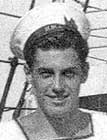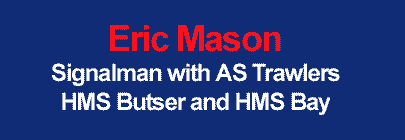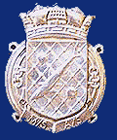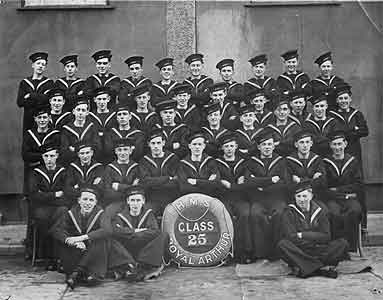


 |
 |
 |
| The following was written by Eric Mason in response to a request from one of his daughters who is a primary school teacher. She wanted to give her class a feel for what life was like for young people during World War II. The piece was written with the age of the audience in mind but is no less moving for all that. With a friend of mine, a Post Office messenger like myself, I had gone to the Royal Navy Recruiting Office when I was 16 year old to volunteer for the Navy. They took our names then and apologized for the fact that they were not allowed to take us as Boy Seamen at 16 years and that we would have to wait until we were called up at 18 years. They did tell us however if we volunteered just before 18 years the Navy would take us then. What they didn't tell us was that they would write to our parents confirming this. When the letter arrived, my mother nearly raised the roof but my father took it very well, and in April 1943 I joined the Royal Navy aged 17 years 9 months. My first 'ship' was HMS Royal Arthur better known as Butlins Camp at Skegness, for kitting out, basic training in seamanship, then selection for the particular branch you would be in. Mine turned out to be the Signals Branch and together with about 50 others I was sent by train to HMS Scotia on the banks of the River Clyde in Scotland just outside Ayr. It was another Butlins Holiday Camp. We
lived in Nissen Huts, 20 double tiered bunk beds in each, with an iron
Stove at either end to keep us warm at night. The huts were newly erected
and had not had the end doors and windows put in. Although it was May
we were still getting light snow showers and frost at night, so it was
a bit on the cold side for about a week after we arrived. |
 |
The course of training was very intensive and included all forms of signaling, Morse sending and receiving by W/T (Wireless Telegraphy), lamp and flag, visual by semaphore (hand flags and mechanical), signal flag hoists on the mast. The Signal School had a 60 foot mast and we had to learn to climb it, practicing until it became second nature. Our instructors were Chief Yeomen or Yeomen of Signals and they quickly told us not to get too 'cocky' about being able to climb the mast as we were the ones who would replace the signal halyard ropes and the W/T aerials on board ship and they always seemed to break in the worst possible weather. The ship's mast would not keep still like the one at the Signal School. Every movement between each period of instruction was done at the 'double march'. Only instructors and officers were allowed to walk during instruction periods. |
| (above) Class 25 HMS Royal Arthur April 1943 |
By the end of October it was the first exams and we were given our various postings. I was one of 6 in my class who were posted to Lowestoft, the Base for the Royal Navy Patrol Service. On arrival in Lowestoft we reported to the Drafting Master at Arms Office in the Base and were all given 14 days leave (Pre-Foreign Service) but we could not find out where we were going. The leave passed by very quickly and I was soon back in Lowestoft and billeted in an old house with some 20 other sailors awaiting draft On the 11th December 1943 I was on a night train to Glasgow with my fellow Ordinary Signalman colleagues, all of us being just 18 years of age. The train took us through various other stations and we picked up a number of other coaches filled with Army and RAF personnel before finally reaching Glasgow in the early morning and being shunted right onto the Dockside, then transferred straight aboard a troopship which was named Leopoldville. This was the name of a town in the Belgian Congo in Africa, after which the ship had been named and it flew the Belgian flag We
left the dock as soon as all the forces had embarked and joined a large
convoy which had formed up in a wide part of the Clyde Estuary off Greenock
and Gourock, known as the 'Tail of the Bank'. As soon as it became dark
on the 12th December we set sail from the Clyde, up around the north
of Ireland and out into the Atlantic and into the teeth of a full gale.
Not a single light could be seen. By morning practically everyone in
our mess deck was seasick including me. None of us wanted food and couldn't
care if we lived or died. Fortunately it soon passed and we were eating
again, but confined below deck for two days until the weather moderated
and no more heavy seas were breaking over the bows. The ships were spread over a great area of the sea and our escort consisted of a large number of destroyers and cruisers but they were never near enough for us to find out their names. The main ship of the convoy which had the Commodore on board was, I believe, named the 'Highland Monarch', a pre-war Royal Mail Liner on the Australia Run. Quite
frequently during the Boat Drills which were not exercises, we heard
and felt the cushion of exploding depth charges dropped by the escorts.
Changes of course were quickly made, but everyone was straining their
eyes, gazing across the sea for any sign of a U-boat. |
 |
 |